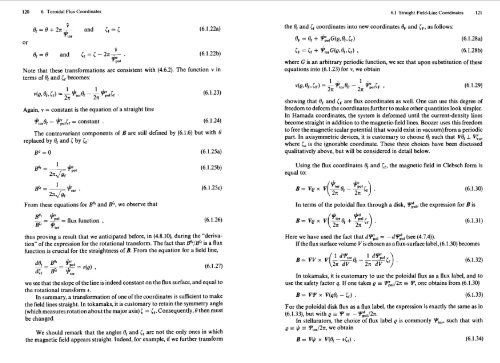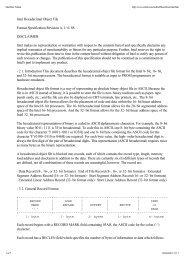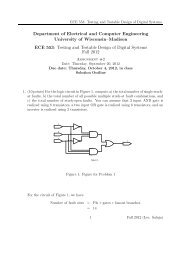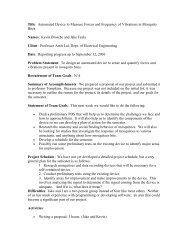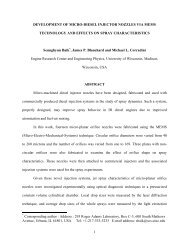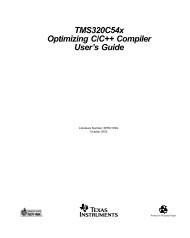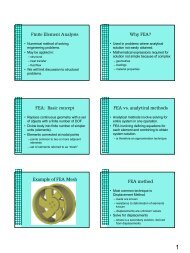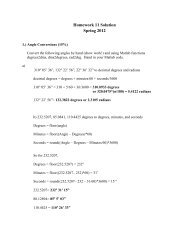Flux Coordinates and Magnetic Field Structure - University of ...
Flux Coordinates and Magnetic Field Structure - University of ...
Flux Coordinates and Magnetic Field Structure - University of ...
You also want an ePaper? Increase the reach of your titles
YUMPU automatically turns print PDFs into web optimized ePapers that Google loves.
120 6. Toroidal <strong>Flux</strong> <strong>Coordinates</strong> 6.1 Straight <strong>Field</strong>-Line <strong>Coordinates</strong> 121<br />
V<br />
8,=8 <strong>and</strong> [,=[-2nT. (6.1.22b)<br />
Yiol<br />
Note that these transformations are consistent with (4.6.2). The function v in<br />
terms <strong>of</strong> 8, <strong>and</strong> [, becomes:<br />
Again, v = constant is the equation <strong>of</strong> a straight line<br />
)jtoref - eel[, = constant . (6.1.24)<br />
The contravariant components <strong>of</strong> B are still defined by (6.1.6) but with 8<br />
replaced by 8, <strong>and</strong> [ by [,:<br />
From these equations for Be' <strong>and</strong> &r, we observe that<br />
Be,<br />
-- - !!iol - flux function ,<br />
fi ytor<br />
thus proving a result that we anticipated before, in (4.8.10), during the "derivation"<br />
<strong>of</strong> the expression for the rotational transform. The fact that Bef/Bcr is a flux<br />
function is crucial for the straightness <strong>of</strong> B. From the equation for a field line,<br />
we see that the slope <strong>of</strong> the line is indeed constant on the flux surface, <strong>and</strong> equal to<br />
the rotational transform t.<br />
In summary, a transformation <strong>of</strong> one <strong>of</strong> the coordinates is sufficient to make<br />
the field lines straight. In tokamaks, it is customary to retain the symmetry angle<br />
(which measures rotation about the major axis) ( = [,. Consequently, 8 then must<br />
be changed.<br />
We should remark that the angles 8, <strong>and</strong> [, are not the only ones in which<br />
the magnetic field appears straight. Indeed, for example, if we further transform<br />
the 8, <strong>and</strong> [, coordinates into new coordinates 8, <strong>and</strong> (, as follows:<br />
where G is an arbitrary periodic function, we see that upon substitution <strong>of</strong> these<br />
equations into (6.1.23) for v, we obtain<br />
showing that 8, <strong>and</strong> [, are flux coordinates as well. One can use this degree <strong>of</strong><br />
freedom to deform the coordinates further to make other quantities look simpler.<br />
In Hamada coordinates, the system is deformed until the current-density lines<br />
become straight in addition to the magnetic-field lines. Boozer uses this freedom<br />
to free the magnetic scalar potential (that would exist in vacuum) from a periodic<br />
part. In axisymmetric devices, it is customary to choose 8, such that V4 1 V(,,<br />
where 5, is the ignorable coordinate. These three choices have been discussed<br />
qualitatively above, but will be considered in detail below.<br />
Using the flux coordinates 8, <strong>and</strong> [,, the magnetic field in Clebsch form is<br />
equal to:<br />
In terms <strong>of</strong> the poloidal flux through a disk, !Piol, the expression for B is<br />
Here we have used the fact that d qO1 = - d Y,"Ol (see (4.7.4)).<br />
If the flux surface volume V is chosen as a flux-surface label, (6.1.30) becomes<br />
In tokamaks, it is customary to use the poloidal flux as a flux label, <strong>and</strong> to<br />
use the safety factor q. If one takes Q = YioI/2n = Y, one obtains from (6.1.30)<br />
-<br />
- For the<br />
-<br />
poloidal disk flux as a flux label, the expression is exactly the same as in<br />
(6.1.33), but with Q = Y YkI/2n.<br />
In stellarators, the choice <strong>of</strong> flux label Q is commonly Ytor, such that with<br />
Q = $ YtOr/2n, we obtain


